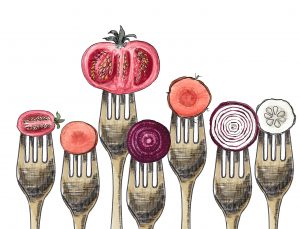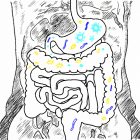Trending
Popular Diets: Sink your teeth into five popular diets
BY VANESSA ROSET
September, 2016

Gluten and Vegan and Raw, oh my! Today’s diet culture is full of familiar buzzwords, touted by athletes and celebrities as the key to their mental and physical well-being. With each diet claiming to hold the solution to our nutritional woes, it can be difficult to determine which diets are actually best for our bodies. So what’s fact, and what’s fiction? To help you decide, we’re breaking down the five most popular eating plans of our modern age.
The Paleo Diet
Pioneered by Health Sciences professional Dr. Loren Cordain, the paleo diet advocates a return to our roots. Also referred to as the “caveman diet,” it’s gained a number of celebrity supporters since its inception in 2002.
The Philosophy: The diet emphasizes foods that were eaten prior to the agricultural revolution. Followers seek out naturally occurring food sources that can be hunted, foraged or gathered.
The Menu: Seafood, lean meat (preferably organic and grass-fed), eggs, vegetables, fruits, nuts, seeds and healthy oils (e.g., coconut, avocado, flaxseed, etc.) are in. Cereal grains, dairy, legumes, potatoes, refined sugar and vegetable oils, coffee, alcohol and any processed foods are out.
The Praise: The paleo way can particularly benefit diabetes sufferers due to its low glycemic load. Studies suggest it also improves heart health and may even help people with auto-immune diseases, such as multiple sclerosis and arthritis.
The Criticism: Modern meat sources have very different nutritional profiles than their wild ancestors, which have some experts warning against eating too much meat and toxin-rich seafood. The diet also excludes dairy and legumes, leading some to believe it may be nutrient-deficient.
The Gluten-Free Diet
Perhaps the fastest-growing diet trend of the last few years, the popularity of going gluten-free has led to a multi-million–dollar industry and the rebranding of many products to suit the market. Around 1 in 133 Canadians actually needs the diet; others follow it for its alleged benefits.
The Philosophy: The diet is essential for sufferers of celiac disease who are unable to process gluten, a protein found in wheat, rye and barley.
The Menu: Wheat in all forms is prohibited. Celiac sufferers must read food labels carefully, as gluten can hide in thickening agents, condiments, seasoning mixes, sauces, oats and processed foods.
The Praise: The diet eliminates the symptoms of celiac disease, which include gas, stomach pain, fatigue, skin rashes and joint pain. Many non-celiacs who go gluten-free boast higher energy levels, weight loss and clearer skin.
The Criticism: Gluten-free products are often expensive and heavily processed. The substitute starches used can have high glycemic indexes and little nutritional value. People who eliminate high fibre, whole grain and enriched wheat products from their diets may experience iron, folate, calcium and other nutritional deficiencies.
The Vegetarian Diet
Growing awareness about the potential effects of meat-eating in both our bodies and our environments has more and more people jumping on the veggie train. The vegetarian diet is largely supported by health professionals, as long as followers take appropriate planning measures to ensure their nutritional needs are being met.
The Philosophy: Vegetarians generally avoid all meat sources for a variety of reasons, which can be tied to health concerns, animal rights, environmental welfare and religious beliefs.
The Menu: Lacto-vegetarians eat dairy but do not eat any meat or eggs. Ovo-vegetarians allow eggs but exclude meat and dairy. Lacto-ovo vegetarians allow dairy and eggs but avoid all meat.
The Praise: Many studies support the health benefits of vegetarianism, which include lower risk of diabetes, coronary heart disease, high blood pressure and even certain cancers.
The Criticism: There is a possibility for nutritional deficiencies since some essentials, like Vitamin B-12, can be found only in animal sources. Replacing meat with carbohydrates, starchy foods, refined sugars or heavily processed veggie alternatives can also have adverse effects on health.
The Vegan Diet
The vegan diet has garnered a lot of attention in the news lately; back in August, Italian MP Elvira Savino proposed to make it illegal for parents to feed their children according to its guidelines. The action was spurred by the hospitalization of several malnourished vegan infants.
The Philosophy: Veganism principles are strictly tied to animal and environmental welfare and extend beyond diet alone. Most vegans will also avoid any animal-derived products, such as leather, as well as anything that involves animal testing.
The Menu: Anything originating from an animal is out—meat, eggs, dairy, even honey. A balanced diet avoids processed foods and refined vegetable oils and includes lots of fruits and vegetables, beans and lentils, whole grains, and healthy natural oils and dairy substitutes.
The Praise: Research indicates that vegans who eat a balanced diet and supplement appropriately have even lower rates of obesity, diabetes, hypertension and certain cancers than their vegetarian cousins.
The Criticism: The diet requires a lot of planning in order to be nutritionally sound. Critics argue that it is inappropriate for children, who have different nutritional requirements than adults.
The Raw Diet
When it comes to the raw diet, the jury is at odds. Many health professionals recognize the importance of eating raw fruits and -vegetables daily but caution against cutting out the benefits that cooking brings to the table. Other advocates, like tennis power-house Venus Williams, challenge those notions, crediting raw food as fundamental to their success.
The Philosophy: Raw foodists believe that valuable enzymes in our food are destroyed through cooking. Food can be dehydrated but is never heated above 40°C.
The Menu: Most common are the raw food vegans, who eat only fresh, uncooked, unprocessed (and preferably organic) fruits, vegetables, nuts and seeds. Some diets include raw meat, seafood, eggs, dairy products and honey. Balanced diets emphasize sprouted grains and fermented foods, such as kefir and sauerkraut.
The Praise: Supporters claim the diet im-proves skin, boosts memory, strengthens immunity and helps headaches, allergies, inflammation, heart health, arthritis -and -diabetes.
The Criticism: Cooking kills bacteria, helps us digest certain vegetables and facilitates the absorption of nutrients from antioxidant-rich foods like sweet potatoes and tomatoes. Health expert Christopher Wanjek elaborates: “soups are full of nutrients that would not be available in a pot of raw carrots, onions, parsnips and potatoes.”
When determining a meal plan, consider this: proper research is always important. Talking to doctors or nutritionists, taking appropriate supplements, considering the needs of different age groups and planning meals accordingly will help ensure that your diet is met with success. t8n
Did You Know?
The glycemic index (GI) ranks carbohydrate-rich foods according to how they affect blood sugar levels. Foods with low GI values are digested and metabolized more slowly; they limit spikes in blood sugar, contributing to heart health, weight loss and lowered inflammation.
Did You Know?
There are plenty of ways to ramp up calcium intake without consuming dairy products. Collard greens, broccoli, kale, figs, white beans and tofu are all excellent sources. You’ll find the same amount of calcium as a glass of milk in just one cup of cooked bok choy.












